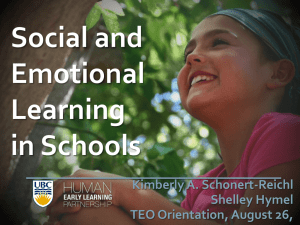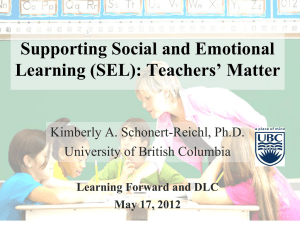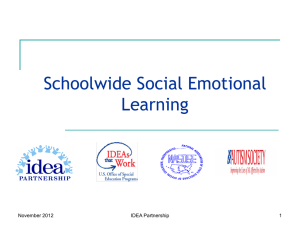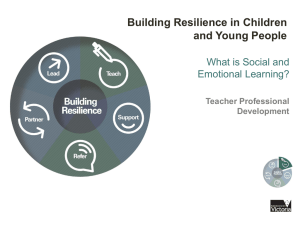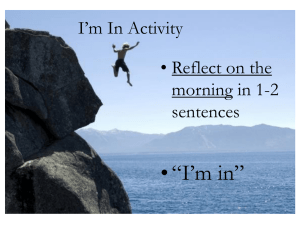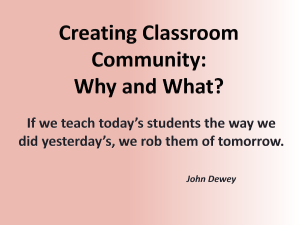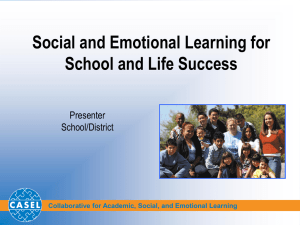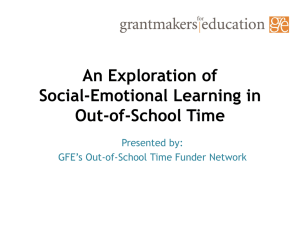Guidelines for Implementing Social and Emotional Curriculum K
advertisement
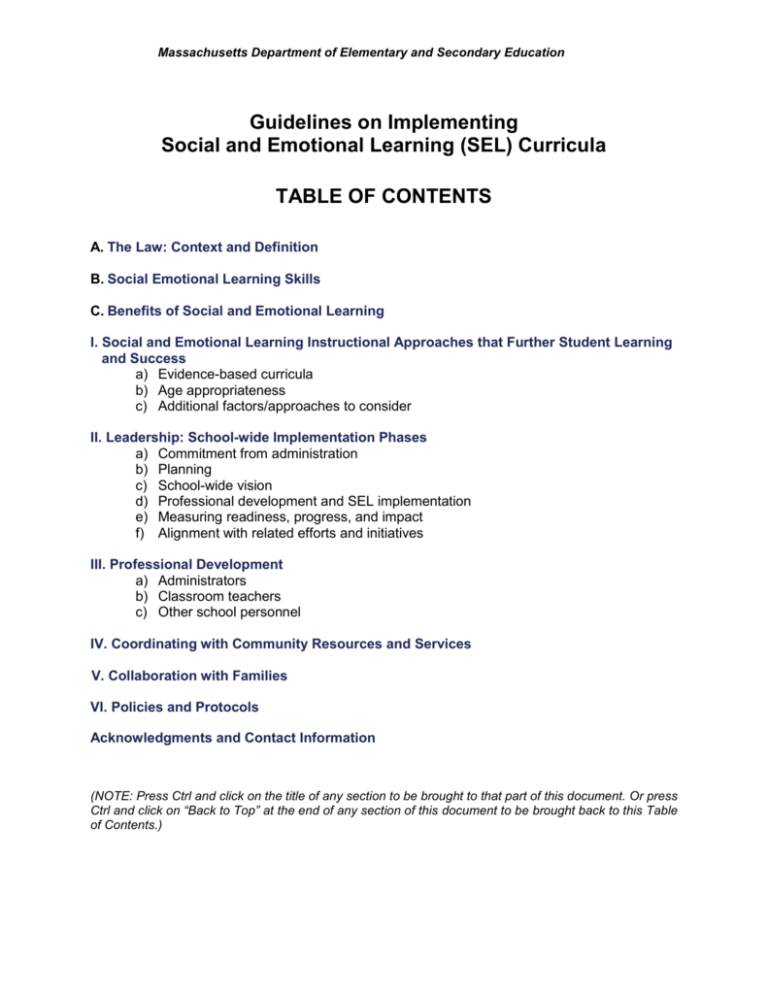
Massachusetts Department of Elementary and Secondary Education Guidelines on Implementing Social and Emotional Learning (SEL) Curricula TABLE OF CONTENTS A. The Law: Context and Definition B. Social Emotional Learning Skills C. Benefits of Social and Emotional Learning I. Social and Emotional Learning Instructional Approaches that Further Student Learning and Success a) Evidence-based curricula b) Age appropriateness c) Additional factors/approaches to consider II. Leadership: School-wide Implementation Phases a) Commitment from administration b) Planning c) School-wide vision d) Professional development and SEL implementation e) Measuring readiness, progress, and impact f) Alignment with related efforts and initiatives III. Professional Development a) Administrators b) Classroom teachers c) Other school personnel IV. Coordinating with Community Resources and Services V. Collaboration with Families VI. Policies and Protocols Acknowledgments and Contact Information (NOTE: Press Ctrl and click on the title of any section to be brought to that part of this document. Or press Ctrl and click on “Back to Top” at the end of any section of this document to be brought back to this Table of Contents.) Massachusetts Department of Elementary and Secondary Education Guidelines on the Implementation of Social and Emotional Learning (SEL) Curricula K-12 Guidelines on Implementing Social and Emotional Learning (SEL) Curricula Developing students’ social and emotional competencies helps schools create safe learning environments that contribute to academic achievement for all. This document contains guidelines for schools and districts on how to effectively implement social and emotional learning curricula for students in grades K-12. The information provided relates to leadership, professional development, resource coordination, instructional approaches, policies and protocols, and collaboration with families. These guidelines and related resources are posted and will be updated on the Department’s bullying prevention and intervention pages. A. The Law: Context and Definitions Chapter 92 of the Acts of 2010: An Act Relative to Bullying in Schools, approved by the Governor, May 3, 2010, called for a number of requirements to help schools prevent bullying. One of the requirements for the Department of Elementary and Secondary Education (the Department) was the creation of guidelines for schools on the implementation of social and emotional learning (SEL) curricula. The charge was included in Section 16 as follows: “The department of elementary and secondary education shall publish guidelines for the implementation of social and emotional learning curricula in kindergarten to grade 12, inclusive, on or before June 30, 2011. The guidelines shall be updated biennially.” As defined by the law, SEL is the process through which students and adults acquire the knowledge, attitudes, and skills associated with the core areas of social and emotional competency. More specifically: Social and emotional learning means the processes by which children acquire the knowledge, attitudes and skills necessary to: recognize and manage their emotions, demonstrate caring and concern for others, establish positive relationships, make responsible decisions, and constructively handle challenging social situations. B. Social Emotional Learning Skills The goals of SEL curricula include teaching the following basic skills:1 1 Self-Awareness focuses on identifying and recognizing emotions; accurate self-perception; strengths, needs, and values; and self-efficacy. Self-Management includes impulse control and stress management; self-motivation and discipline; goal setting; and organizational skills. Safe and Sound: An Educational Leaders Guide to Evidence-Based Social and Emotional Learning Programs, Collaborative for Academic, Social and Emotional Learning (CASEL, 2003). Massachusetts Department of Elementary and Secondary Education Guidelines on the Implementation of Social and Emotional Learning (SEL) Curricula K-12 Social Awareness addresses perspective taking; empathy; difference recognition; and respect for others. Relationship Skills encompasses communication; social engagement and relationship building; working cooperatively; negotiation; refusal; conflict management; and help seeking. Responsible Decision Making includes problem identification and situation analysis; problem solving; evaluation and reflection; and personal, social, and ethical responsibility. Active forms of learning, such as role playing and behavioral rehearsal, provide students with opportunities to practice these skills. Skills are taught primarily by classroom teachers using scripted role plays that focus on specific skills such as responsible decision making. Once students have demonstrated proficiency in using the appropriate skill for a specific situation, classroom teachers can provide opportunities for application of skills throughout the school day and in specific subject classes. Again, SEL skills are best taught when infused throughout the school day and in all aspects of a students’ experience. Educational specialists and counseling staff should model skills and expand students’ capacity for skill practice in one on one and small group situations. Particular skills can be targeted for development through focused learning objectives. Recommended practices for teaching skills often use the acronym SAFE:2 Sequenced: Does the program apply a planned set of activities to develop skills sequentially in a step-by step fashion? Active: Does the program use active forms of learning such as role-plays and behavioral rehearsal with feedback? Focused: Does the program devote sufficient time exclusively to developing social and emotional skills? Explicit: Does the program target specific social and emotional skills? C. Benefits of SEL Implementation of SEL programs in schools provides a foundation for creating a safe learning environment where all students can succeed. Effective programs include multi-component school-based interventions involving classroom-based curricula that focus on teaching students skills to enhance social and emotional competencies as well as academic learning. These critical social-emotional competencies involve skills that enable students to calm themselves when angry, initiate friendships and resolve conflicts respectfully, make ethical and safe choices, and contribute constructively to their community.3 i. 2 Academic achievement Through SEL, students can learn to handle their feelings for a number of purposes, including helping them to focus on their studies and improve individual performance. Better social skills have been shown to correlate with students’ increased time-on-task and with higher achievement scores and higher grades. Payton, J., Weissberg, R.P., Durlak, J.A., Dymnicki, A.B., Taylor, R.D., Schellinger, K.B., & Pachan, M. (2008).The positive impact of social and emotional learning for kindergarten to eighth-grade students: Findings from three scientific reviews. Chicago, IL: Collaborative for Academic, Social, and Emotional Learning. 3 Collaborative for Academic, Social, and Emotional Learning (CASEL), 2005; Elias, Zins, Weissberg, Frey, Greenberg, Haynes, Kessler, Schwab-Stone, & Shriver, 1997; Zins & Elias, 2006. http://www.CASEL.org. Massachusetts Department of Elementary and Secondary Education Guidelines on the Implementation of Social and Emotional Learning (SEL) Curricula K-12 ii. Healthy personal-social development Through SEL, students can learn to exhibit pro-social behavior and character skills that will serve them well not only in school, but throughout their lives. They can learn to recognize and manage their emotions, establish healthy relationships, set positive goals, meet personal and social needs, make responsible decisions, and solve problems. iii. School climate A sustainable, positive school climate can be supported and furthered by SEL, as can efforts to reduce dropout rates, to foster youth development and academic achievement, and to increase the knowledge, skills, and disposition necessary for students to be responsible and productive members of the school community and society as a whole. SEL can increase attendance, and a related sense of connection to school and to adult members of the school community. When school members feel safe, valued, cared for, engaged, and respected, learning can measurably increase. iv. Key findings on effective SEL work in schools4 include the following: Improved academic achievement: Students involved in SEL programming experienced significantly greater academic achievement than students who do not receive SEL. Improved school attitudes and behaviors: SEL instilled greater motivation to learn, a deeper commitment to school, increased time devoted to schoolwork, better classroom behavior, and improved attendance and graduation rates. Fewer negative behaviors: Among students receiving SEL instruction, disruptive class behavior, noncompliance, aggression, delinquent acts, and disciplinary referrals decreased significantly. Reduced emotional distress: Reports of student depression, anxiety, stress, or social withdrawal significantly decreased among students receiving SEL instruction. Back to Top I. Social and Emotional Learning Instructional Approaches that Further Student Learning and Success a) Evidence-based curricula Research clearly demonstrates that social and emotional skills can be taught through school-based programs. Today, numerous nationally-available, evidence-based SEL curricula provide systematic classroom instruction that enhance students’ abilities to recognize and manage their emotions, appreciate the perspectives of others, establish prosocial goals and solve problems, and use a variety of interpersonal skills to handle the challenges of growing up in society. In addition to skills-building components, a number of SEL curricula feature elements designed to foster positive classrooms and school environments, and to establish practices that build trust and rapport among and between students and adults. 4 Durlak, J.A. Weissberg, R.P., Dymnicki, A.B., Taylor, B.D., & Schellinger, K.B. The impact of enhancing students’ social and emotional learning: A meta-analysis of school-based universal interventions (2010). Massachusetts Department of Elementary and Secondary Education Guidelines on the Implementation of Social and Emotional Learning (SEL) Curricula K-12 Instructional components should be sequenced, well-designed lessons intended for use in core educational classrooms. A prescribed sequence of lessons in a curriculum promotes student learning, building upon what has been taught in earlier levels and prepares for what will be taught in later grades. Lesson plans for each grade help schools implement programs with integrity. SEL needs to be promoted in all classrooms, so that all students will benefit. Lessons should be incorporated into the learning day and not considered solely as a supporting initiative. Curricula should be of sufficient intensity and duration with a minimum of eight lessons in each program year. Tools for monitoring implementation of programs can assist teachers in achieving a high level of fidelity. (For more details on monitoring, see Measuring readiness, progress, and impact bullet in the Leadership IIe section above.) Curricula should teach students skills and provide opportunities for them to develop their skills on a daily basis. Sharing circles, morning meetings, cooperative learning groups, advisory programs, and proactive classroom management are all components that support evidence-based implementation. Although an SEL curriculum is only one component of evidence-based school-wide SEL programming, it can be the cornerstone of the entire effort. Well-designed curricula implemented in all classes will ensure that students receive consistent and developmentally appropriate skill instruction. Curricula selection should be based on the specific needs of the students and linked to the goals and proven outcomes of the program. School-wide classroom instruction allows all faculty and staff to share a common approach and language for addressing social, emotional, and behavioral issues. In addition, many curricula include components for involving the family, community, and school mental health and support personnel in promoting SEL, and provide the necessary professional development for using the program. b) Age appropriateness SEL should be started in preschool and continued through high school, addressing clearly specified learning objectives for each grade and developmental level. c) Additional factors/approaches to consider The varying needs of individual students, schools, and communities should be considered when making decisions about curricula. Cultural sensitivity, respect for diversity, and any necessary support for vulnerable populations should be emphasized. SEL interventions can be effective in both school and after-school settings; for schools in urban, suburban, and rural areas; and for racially and ethnically diverse student bodies. Back to Top II. Leadership: School-wide Implementation Phases a) Commitment from administration The administration commits to implementing and sustaining a school-wide SEL initiative and engages key stakeholders. Stakeholders include, but are not limited to, administration, faculty and staff, students, parents/guardians/families, and community members. As a part of the commitment, senior leaders identify key people to delegate responsibility for Massachusetts Department of Elementary and Secondary Education Guidelines on the Implementation of Social and Emotional Learning (SEL) Curricula K-12 overseeing SEL efforts, for moving forward these efforts, and for effectively communicating with and involving top leadership. For optimum success, these efforts need to be supported by district leadership as well. b) Planning Administration conducts a needs assessment and determines what will meet the identified needs including, but not limited to, plans for professional development, the types of programs and instruction to implement at what time and how, and how progress will be assessed. Schools should avoid the adoption of a random assortment of programs to address social and emotional issues. Adopting multiple programs without a thoughtful plan as to how they are well-coordinated can create confusion and competition for time with lessons in core academic learning areas. Each school should develop its own plan for SEL implementation and climate improvement following district-wide guidelines. The plans should align across the grade levels K-12. With a coordinated approach, key elements of social and emotional learning can serve as an organizing framework for all of a school’s academic, prevention, health, and youth development activities. c) School-wide vision The principal and related stakeholders create and share a school-wide vision of students’ social, emotional, academic development for a safe and supportive learning environment. The vision should include a framework for supporting children in acquiring the knowledge, attitudes, and skills necessary to recognize and manage their emotions, demonstrate caring and concern for others, establish positive relationships, make responsible decisions, and constructively navigate challenging social situations. d) Professional development and SEL implementation Districts and schools conduct professional development and pilot SEL programming. (See Professional Development section II below for more details.) e) Measuring readiness, progress, and impact Rubrics and methods are used to measure the progress and impact of SEL programs. Educators use these data to inform decisions about continuing, modifying, and/or changing the future course of action. Assessment tools measure a broad range of academic outcomes such as higher order thinking, analytical, creative, and practical skills. Instruments are necessary not only for the measurement of SEL implementation and outcomes, however. Measuring tools can help a school/school district determine readiness for SEL implementation and identify factors that contribute to and/or impede effective implementation. These tools can allow a school to identify which social emotional learning skills are already present in other curricula, such as health and prevention education, and which may need to be added. Additionally, self-assessment tools for administrators, teachers, and other users can provide information on the degree and fidelity of implementation. The tools may assist the school in understanding the extent to which schools and classroom environments are supportive of SEL. All schools should help their students meet their established SEL standards and engage in regular assessment of their progress. Massachusetts Department of Elementary and Secondary Education Guidelines on the Implementation of Social and Emotional Learning (SEL) Curricula K-12 f) Alignment with related efforts and initiatives Many schools and districts in Massachusetts are moving forward with a number of initiatives related to SEL. Aligning these efforts can help prevent fragmented contradictory communication and ineffective messages for students. The organizational structure of these guidelines is aligned with the Behavioral Health and Public Schools Framework and Assessment Tool. Additional examples of SEL- related statewide initiatives include, but are not limited to: The Conditions for School Effectiveness, the Race to the Top Wrap Around Zone Initiative, the Massachusetts Tiered System of Supports, the Bullying Prevention and Intervention Model Plan, the Massachusetts Model for Comprehensive School Counseling, and Service Learning. Moreover, local SEL curricula can align with efforts that may include, but are not limited to, initiatives related to character education, civic education, diversity, youth development, team teaching, etc. To sustain a successful district-wide initiative, support for SEL is needed from a broad-based community-wide coalition that understands the importance of SEL and advocates for and helps to support effective SEL programming for all children and youth. Back to Top III. Professional Development a) Administrators Leadership is a critical factor in the effective implementation of high-quality SEL, and it should be a priority central to a school’s educational mission. Building administrators and school leaders participate in training with school faculty and staff, not only to understand what is being implemented, but also to demonstrate the key role leadership plays in creating a climate conducive to effective SEL implementation. Principals and school directors/leaders model and reinforce skills and behaviors in both large and small group settings with staff and students and as opportunities arise throughout the school day. Adult role modeling of appropriate SEL behaviors should be a primary focus. An important emphasis of professional development in a SEL focused system should be on relational skills and relationship building. b) Classroom teachers To be most effective, teacher training needs to include guidance in how to integrate academic content and SEL. Teaching methods and classroom climate may need adjustments to enhance social and emotional learning. Data indicate that programs are most effective when incorporated into routine educational practice; therefore it is imperative that teachers model and reinforce SEL competencies with all students in their daily interpersonal and group interactions. Data also suggest that ongoing technical assistance and performance feedback are vital. For teachers in all settings to succeed, the extent and quality of teacher training are critically important. c) Other school personnel All adult members of a school community should receive training to ensure that everyone can support, model, and reinforce SEL skills in a variety of settings beyond the classroom. Massachusetts Department of Elementary and Secondary Education Guidelines on the Implementation of Social and Emotional Learning (SEL) Curricula K-12 Investment in initial and continuing staff development for all school personnel is one of the most important factors for program success. To the extent possible, districts and schools should create opportunities to create crosssystem professional development that includes administrators, classroom teachers, behavioral health specialists, support service professionals, and families. Back to Top IV. Coordinating with Community Resources and Services The impact of school-based SEL initiatives can be enhanced by extending outwards to collaborate with child-serving community providers. These efforts can include a coordinated and shared approach with after-school programs, athletics, and other recreational and social activities in community as well as health and human service agencies. Additionally, programs that include strategies involving students in the community, as well as community members in school-based instruction such as service learning, can enhance SEL competencies. Furthermore, sharing training opportunities and exploring partnerships with community-based agencies can improve the effectiveness of all involved in implementation of SEL practices. Back to Top V. Collaboration with Families Evidence-based curricula contain an education component specifically designed for parents/families (including guardians and other actively involved family members). Parents and family members should be provided with that information to support application and modeling of SEL- related skills and attitudes at home. By orienting them to the skills and prompts, and helping them understand how best to coach their children, parents and family members can support the values and processes of the school initiative. Programs that attempt to involve families through regular activities and by using more than one approach engage parents in the process. Family collaboration can be accomplished by a variety of approaches as suggested below. District and school leaders articulate their intent to engage families as essential partners in their efforts to promote SEL by including in district vision statements and school implementation plans and activities that involve all families. This includes parent participation in the development of plans, identifying professional development goals, assessing and prioritizing needs, and evaluating student progress. School personnel receive professional development and demonstrate awareness and sensitivity to cultural, linguistic, and other aspects of family diversity (e.g., disabilities, socioeconomic levels, sexual orientation and gender identity/expression, etc.), including culturally-specific beliefs and concerns related to social emotional learning. Massachusetts Department of Elementary and Secondary Education Guidelines on the Implementation of Social and Emotional Learning (SEL) Curricula K-12 School staff work together to create a safe, welcoming environment in which all families feel that their voices are valued by creating ways in which families can voice their thoughts and suggestions, including opportunities for anonymous feedback. School leadership and staff receive professional development and skill-building on interacting with families in an effective and supportive manner, being comfortable and knowledgeable addressing students’ emotional and behavioral challenges with parents, and providing information on community resources. The school partners with Parent Teacher Organizations/Associations (PTO/PTA), School Councils, Special Education Parent Advisory Councils, and similar organizations to regularly share information about school-wide programs and school efforts to address the behavioral health of all students, to provide educational forums to parents on topics related to promoting behavioral health as well as social programs that provide opportunities for families to engage in the school community, e.g., game or movie nights, morning and evening meals. Families are surveyed to gather input on particular topics for forums and interests for activities or social gatherings. Planning may include the need to provide transportation and child care to facilitate the attendance of some families at these events, the need to ensure that notice of events is provided in the language of the home, and the need for interpreter availability or multiple events held in different languages to accommodate the linguistic diversity of the school community. Back to Top VI. Policies and Protocols Schools should review all policies and protocols to ensure that they reflect and reinforce a clear SEL approach at all levels of the system. A particular focus should be on school discipline policies to ensure that they reflect the necessary balance between accountability and an understanding of supporting SEL strategies. At the district level, discipline policies or initiatives might include a focus on prevention and promotion rather than zero tolerance efforts (e.g., restorative justice, peer juries, community service, in-school suspension that includes skill building and problem solving).5 Back to Top ACKNOWLEDGMENTS AND CONTACT INFORMATION: These guidelines were written by Department staff after a review of resources including, but not limited to, research studies and guidance from the Collaborative for Academic, Social, and Emotional Learning (CASEL), the University of California, Los Angeles (UCLA), and other institutions of higher learning. The Department wishes to thank the many individuals and representatives from schools and organizations who also contributed to providing input and feedback on these guidelines. The guidelines will be updated over time, and at least biennially. Feedback and comments can be directed to the Learning Support Services unit via achievement@doe.mass.edu or 781-338-3010. Guidelines last updated August 2011.ESE 5 Connecting Social Emotional Learning with Mental Health. National Center for Mental Health Promotion and Youth Violence Prevention by the Collaborative for Academic, Social, and Emotional Learning at the University of Illinois at Chicago. January 2008.

